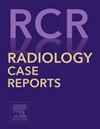Multidisciplinary approach to the accurate diagnosis of parosteal osteosarcoma
Q4 Medicine
引用次数: 0
Abstract
The successful treatment of any disease depends on early and correct diagnosis. A failure to establish an accurate diagnosis can lead to ineffective, often expensive treatment and risky progression of the disease with all the negative consequences, including incurability and death. The parosteal osteosarcoma is an illustrative example of how determining the correct diagnosis can be a challenging task. Parosteal osteosarcoma is a rare malignant bone tumor, mainly affected metaphysis of long bones. It arises from cortical surface of bone and it is usually slowly growing, low-grade, and well-differentiated tumor with good prognosis. Unfortunately, parosteal osteosarcoma is often misdiagnosed as a benign osteochondroma or myositis ossificans what leads to ineffective treatment, disease progression and systemic spreading with later treatment complications. In this article, we discuss a case of 48-years-old male with prolonged diagnosis of parosteal osteosarcoma, initially misdiagnosed as myositis ossificans. The diagnosis was revised and corrected based on results obtained by various approaches, including radiography, ultrasound-guided biopsy, histology, conventional cytology, and molecular biology. On this example, we demonstrate the importance of interdisciplinary collaboration between experts from different areas of health care.
多学科方法对骨旁骨肉瘤的准确诊断
任何疾病的成功治疗都取决于早期和正确的诊断。未能作出准确诊断可能导致无效且往往昂贵的治疗和危险的疾病进展,并带来包括不可治愈和死亡在内的所有负面后果。骨旁骨肉瘤是一个说明性的例子,说明如何确定正确的诊断可能是一项具有挑战性的任务。骨旁骨肉瘤是一种罕见的恶性骨肿瘤,主要累及长骨干骺端。它起源于骨皮质表面,通常是生长缓慢、低级别、分化良好的肿瘤,预后良好。不幸的是,骨旁骨肉瘤经常被误诊为良性骨软骨瘤或骨化性肌炎,导致治疗无效,疾病进展和全身扩散,并伴有后期治疗并发症。在这篇文章中,我们讨论了一个48岁的男性,长期诊断为骨旁骨肉瘤,最初误诊为骨化性肌炎。根据各种方法获得的结果,包括x线摄影、超声引导活检、组织学、常规细胞学和分子生物学,对诊断进行了修订和纠正。在这个例子中,我们展示了来自不同医疗保健领域的专家之间跨学科合作的重要性。
本文章由计算机程序翻译,如有差异,请以英文原文为准。
求助全文
约1分钟内获得全文
求助全文
来源期刊

Radiology Case Reports
Medicine-Radiology, Nuclear Medicine and Imaging
CiteScore
1.10
自引率
0.00%
发文量
1074
审稿时长
30 days
期刊介绍:
The content of this journal is exclusively case reports that feature diagnostic imaging. Categories in which case reports can be placed include the musculoskeletal system, spine, central nervous system, head and neck, cardiovascular, chest, gastrointestinal, genitourinary, multisystem, pediatric, emergency, women''s imaging, oncologic, normal variants, medical devices, foreign bodies, interventional radiology, nuclear medicine, molecular imaging, ultrasonography, imaging artifacts, forensic, anthropological, and medical-legal. Articles must be well-documented and include a review of the appropriate literature.
 求助内容:
求助内容: 应助结果提醒方式:
应助结果提醒方式:


